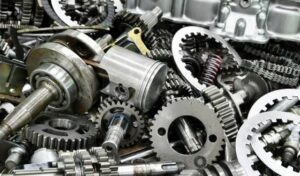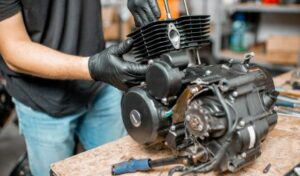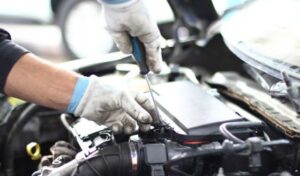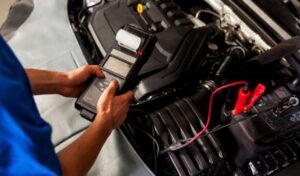Like any mechanical system, motorcycles are complex assemblies of parts designed to work together. The motorcycle’s rectifier is essential. Due to its size and lack of rider interaction, motorcycle rectifiers are often overlooked. Its impact on motorcycle performance is undeniable.
The motorcycle’s rectifier converts the engine’s stator’s AC into DC for battery charging and other electrical components. This process preserves the motorcycle’s electrical system.
If it fails, problems may follow. It can overcharge or undercharge the battery, damaging it or other electrical components. Thus, a working rectifier ensures a smooth ride.
Rectifier’s Role in the Motorcycle’s Electrical System
The charging system—battery, alternator, and regulator—includes the rectifier. As mentioned, it converts AC to DC. The motorcycle’s alternator generates AC, which cannot charge the battery or power its DC electrical devices.
The rectifier takes over. It converts AC into DC to charge the battery and power the electrical system. Thus, it powers the electrical system and charges the battery for engine start-ups.
The rectifier’s DC is regulated to maintain battery and electrical system voltage. Thus, the rectifier and regulator help maintain the motorcycle’s electrical system.
Motorcycle rectifiers are the most essential components of a motorcycle. Without it, the electrical system would malfunction, causing battery issues, electrical component failure, and a poor ride. Proper motorbike maintenance requires understanding its role in the electrical system.
What is A Rectifier and How Does it Work?
A rectifier is an electrical device with one or more diodes that allows electric current to flow in one direction. It converts AC to DC in motorcycles (DC).
The alternator’s stator generates AC, which the battery and other electrical components cannot directly use. This AC is converted into DC by the rectifier’s diodes.
Different Types of Rectifiers Commonly Used in Motorcycles
Motorcycles use single-phase and three-phase rectifiers. The motorcycle’s power requirements determine the choice.
Single-phase Rectifiers:
Smaller motorcycles use single-phase rectifiers. These rectifiers deliver power in one wave per cycle with fewer diodes (usually four). The three-phase rectifier is more efficient than this simpler, cheaper one.
Three-phase Rectifiers:
More powerful motorcycles use three-phase rectifiers. This type has six diodes and delivers power in three waves per cycle. This improves power delivery for motorcycles with higher electrical loads.
Significance of the Rectifier in Converting AC to DC
Motorcycle electrical systems depend on the rectifier’s AC-to-DC conversion. Motorcycle batteries and electrical components use DC and it;s alternators generate AC.
It converts AC into DC for battery charging and electrical components. DC is ideal for charging batteries and powering devices, so this conversion is necessary.
Without this conversion, the motorcycle’s battery may not charge or electrical components may malfunction due to inconsistent power delivery. Thus, a motorcycle’s smooth operation requires the rectifier’s AC-to-DC conversion.
How a Bad Rectifier Affects the Motorcycle’s Electrical System
Poor rectifiers can severely disrupt a motorcycle’s electrical system. A failing rectifier converts AC to DC, resulting in inconsistent DC output. The motorcycle’s battery may overcharge or undercharge, causing premature failure.
Unregulated or spiking voltage from a bad rectifier can damage the motorcycle’s ECU, lights, and ignition system. A faulty rectifier disrupts the electrical system balance, affecting motorcycle performance and reliability.
Indications of a Failing Rectifier
Although the rectifier is internal, several symptoms may indicate a problem. These signs:
Dimming or flickering lights indicate a failing rectifier. Inconsistent power output can disrupt the lighting system.
A failing rectifier may cause the motorcycle battery to drain quickly or not hold a charge. The rectifier may undercharge or overcharge the battery, reducing battery life.
The ignition system, ECU, and sensors can malfunction if this component fails. The fluctuating power supply can damage sensitive components.
A faulty rectifier may drain the motorcycle’s battery, preventing it from starting.
If these symptoms are present, a motorcycle mechanic should inspect it. Early detection and repair of a faulty one can prevent further damage to the motorcycle’s electrical system and ensure smooth and reliable performance.
4 Common Symptoms of a Bad Rectifier on A Motorcycle
1. Overheating Issues
Due to high voltage, failing rectifiers can overheat. This can damage the rectifier and cause a fire. Overheating also damages the motorcycle’s battery, fuses, and wiring.
Overheating melts or burns the rectifier housing or nearby wiring. The rectifier’s temperature may rise, indicating overheating.
2. Inconsistent Battery Performance
The rectifier may not supply enough voltage to charge the battery, resulting in slow charging. This may prevent the motorcycle’s battery from starting or powering electrical components.
A faulty rectifier could overcharge the battery, draining it frequently. The battery discharges quickly, requiring frequent jump-starts or replacements.
3. Irregular or Erratic Engine Behavior
The engine may stall or lose power if the rectifier fails. This could be dangerous when riding fast.
Engine misfires and unusual sounds can result from a failing rectifier. Spark plugs may not receive the consistent voltage needed to ignite the air-fuel mixture in engine cylinders.
4. Electrical Failures and Malfunctions
Non-functional or Erratic Lighting: Engine misfires and unusual sounds can result from a failing rectifier. Spark plugs may not receive the consistent voltage needed to ignite the air-fuel mixture in engine cylinders.
Bad rectifiers can also affect indicators, horns, and ignition systems. Voltage fluctuations can cause them to fail.
Motorcycles depend on the rectifier. To prevent electrical system damage and ensure motorcycle safety and reliability, any signs of malfunction should be addressed immediately.
Diagnostic Methods for Identifying a Bad Rectifier
Visual Inspection of the Rectifier Unit
Visually inspecting the rectifier unit is the first step in diagnosing a problem. Cracks, burns, or melting may indicate overheating or internal failure.
Loose connections, corroded terminals, and physical damage may indicate a rectifier problem. These issues could disrupt electrical power.
Voltage Testing
Another diagnostic tool is multimeter voltage testing. You can measure engine-running DC voltage by connecting the multimeter to the rectifier. If the reading fluctuates or is outside the range, the rectifier may be faulty.
Compare voltage test results to manufacturer specs. The rectifier may need replacement if its output deviates from these specifications.
Load Testing the Charging System
Load testing evaluates the charging system’s operation. You can test the battery, alternator, and rectifier by measuring battery voltage at different RPMs.
If the battery voltage doesn’t rise with engine RPM or exceeds the safe limit, the rectifier may be faulty. The rectifier may be misregulating alternator voltage, causing the battery to overcharge.
These diagnostic methods can identify a bad rectifier and prevent motorcycle electrical system damage. If you’re not comfortable performing these tests, take your motorbike to a mechanic for diagnosis and repair.
How To Fix a Bad Rectifier
Replacing a Faulty Rectifier
Make sure you have the right replacement part and that your motorcycle is off and cool before starting. The rectifier is usually near the battery on a motorcycle. Disconnect the battery once found to avoid electrical issues. Disconnect the rectifier’s wiring harness and unscrew it from the motorcycle frame.
Connect the new rectifier to the wiring harness securely. Mount it to the frame using the old screws. Reconnect the battery and start the motorcycle, testing the new rectifier with a multimeter. Installation is successful if the rectifier works and readings are within the manufacturer’s range.
Repairing a Rectifier
Rectifier issues can’t always be fixed. Replacing faulty component is recommended if its internal diodes fail. Cleaning and tightening terminals fixes loose or corroded connections.
A wire brush and contact cleaner can clean corroded terminals. Replace damaged wiring and secure loose connections. After repairs, test the rectifier with a multimeter.
Motorcycle electrical work can be dangerous if done improperly. Always consult a motorcycle mechanic if you’re unsure. Maintaining your motorcycle’s electrical system and performance requires proper rectifier operation.
Regular Inspection and Cleaning
Clean rectifiers last longer. Dust and debris on the rectifier can overheat and fail it. A soft brush or compressed air can prevent this by cleaning the rectifier and its connections regularly. Check connections for corrosion and clean with a wire brush and contact cleaner to keep electricity flowing.
This component generates a lot of heat. It can stay cool if installed in a well-ventilated area. Make sure heat sinks on rectifiers are unobstructed.
Monitoring Electrical System Performance
Maintaining your motorcycle’s electrical system can also extend its rectifier’s lifespan. Maintain your battery’s voltage. Regular charging system tests can also identify rectifier or alternator issues.
Flickering lights, overcharging batteries, and erratic engine behaviour are signs of a failing rectifier, so address them immediately. Ignoring these signs and riding with a bad rectifier can damage your motorcycle’s electrical system and cost more to repair.
Preventive maintenance extends rectifier life. Following these tips and regularly servicing your motorcycle will keep your rectifier and electrical system working for many miles.
Frequently Asked Questions (FAQs)
Bad rectifiers can kill batteries. If it fails to convert AC power from the alternator to DC power for the battery, undercharging occurs. If it fails to regulate voltage, the battery overcharges and degrades quickly.
Quality, use, and motorcycle maintenance affect a rectifier’s lifespan. With proper care, it can last years or tens of thousands of miles.
Soldering or replacing this components is difficult. A skilled technician can repair this component, but it’s usually easier and more reliable to replace it.
A faulty rectifier can cause overcharged or undercharged batteries, electrical component damage, erratic engine behaviour, and even a complete breakdown. If the motorcycle’s lights or ignition system fail while riding, it can be dangerous.
Rectifiers aren’t interchangeable. Rectifiers are motorcycle-specific. Use a motorcycle-compatible rectifier.
Bad rectifiers can damage motorcycle electrical components. A faulty rectifier can cause voltage spikes or drops, damaging sensitive electrical components like the battery, lights, and electronic control unit (ECU).
Regular motorcycle electrical system inspection and maintenance can prevent rectifier issues. Clean it, secure its connections, and check the battery and charging system regularly.
Bad rectifiers can stop a motorcycle. The engine may stop if the rectifier fails completely. A faulty component may damage other components, causing a breakdown.
Conclusion
As we know, motorcycle rectifiers are vital to the electrical system. The motorcycle’s operation depends on its conversion of AC alternator power into DC battery power. The rectifier keeps the battery charged, lights bright, and electrical components working properly.
Recognizing a failing rectifier and fixing it quickly can prevent costly electrical system damage to the motorcycle. A faulty rectifier can cause battery overcharge, engine instability, and more. It’s important to seek medical attention for these symptoms.
Rectifiers and electrical systems can last longer with regular inspection and maintenance. Clean, connect, and monitor your battery and charging system. Troubleshooting early can help your motorcycle last longer and perform better.
Your motorcycle’s performance and reliability depend on its rectifier. Understanding its function, recognising potential issues, and following regular maintenance can ensure a smooth ride and prolong your motorcycle’s life.






